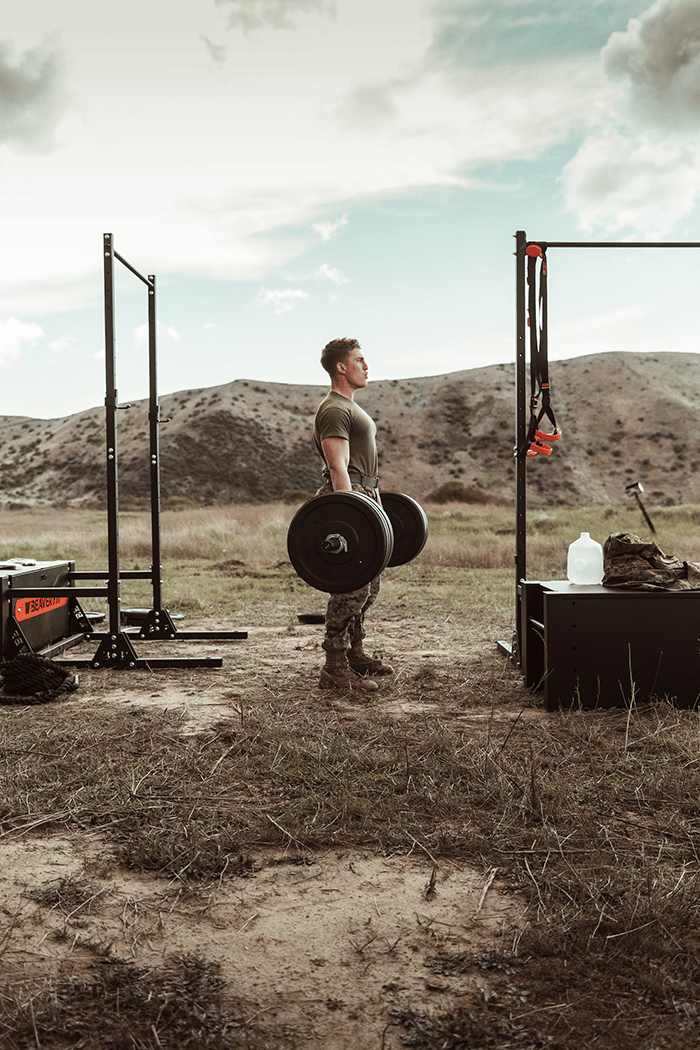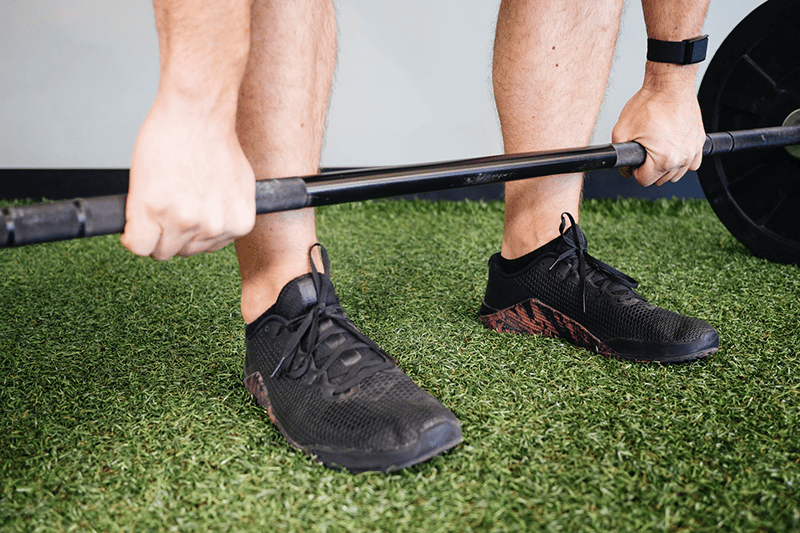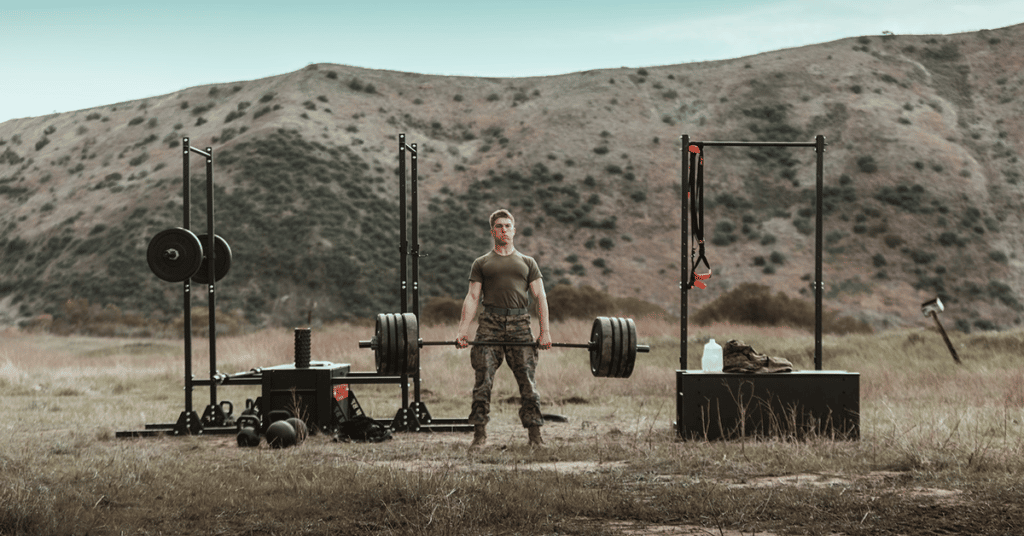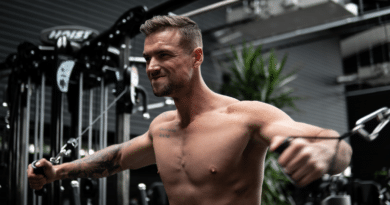The Best Way to Build Muscle and Strength with the Deadlift
This complete guide will teach you everything you need to know about the Deadlift, one of the best compound barbell strength exercises that exists.
We will cover the benefits and drawbacks of the movement, variations and alternatives, technique tips, sets and reps programs, common mistakes and issues people have with the movement – not to mention all your other burning questions answered.
What is the Barbell Deadlift?
The deadlift is a compound barbell movement that targets the hamstrings, glutes, lower back, and traps.

It’s an excellent exercise for building muscle and strength—especially in your posterior chain (the muscles at the back of your body).
The deadlift also improves posture and balance, making it an effective way to boost core strength.
- What is the Barbell Deadlift?
- Why is it Called the Deadlift?
- What are the Benefits of the Deadlift?
- What Muscles Does the Deadlift Work?
- Performing the Deadlift from Different Starting Positions
- Deadlift Variations
- Deadlift Alternatives
- Deadlift Technique Tips
- Common Deadlift Mistakes
- Common Deadlift Issues
- Is the Deadlift Suitable for Beginners?
- How to Build Muscle with Deadlifts (Sets and Reps)
- How to Build Strength with Deadlifts (Sets and Reps)
- How Often Should You Do Deadlifts?
- Conventional Deadlift vs Sumo Deadlift: What’s the Difference?
- Conventional Deadlift vs Romanian Deadlift: What’s the Difference?
- Conventional Deadlift vs Stiff Leg Deadlift: What’s the Difference?
- Conventional Deadlift vs Trap Bar Deadlift: What’s the Difference?
- How to Make Deadlifts Harder
- How to Make Deadlifts Easier
- Do Deadlifts Burn Fat
- Why is My Deadlift so Weak?
- Are Deadlifts Worth it?
- Can I Deadlift in the Smith Machine?
- Should I Deadlift in the Power Rack?
- Do I Need a Spotter to Deadlift?
- I’m Scared of Deadlifts, What Should I Do?
- Why Do Deadlifts Hurt My Hands?
- Should I Use Mixed or Hook Grip When Deadlifting?
- How Can I Increase My Deadlift Weight?
- Is Deadlifting Harder for Taller Athletes?
- Conclusion
Why is it Called the Deadlift?
It is called the Deadlift because each rep must come to a complete “dead” stop on the floor between every rep.
This makes it much harder as it eliminates any benefits recruited from momentum.
What are the Benefits of the Deadlift?
Deadlifts are a compound exercise and therefore train multiple muscle groups at once.
Whether they are performed with a barbell, dumbbell, kettlebell or trap bar, the lifter will still reap the rewards.
- Increased Strength
- Enhanced Hypertrophy
- Better Grip
- Augmented Core Strength and Abs
- Denser Bones
- Increased Immune System
- Elevated mood
What Muscles Does the Deadlift Work?
The deadlift works your entire body, but in particular it targets your quadriceps, hamstrings, glutes, lower back and shoulders.
Your neck and core are also engaged to varying degrees depending on how you perform the exercise.
As a compound exercise that involves multiple joints (such as hip extension and knee flexion) combined with a resisted movement in one or two directions at a time (e.g., hip extension/knee flexion), the deadlift is an excellent way to build strength throughout your entire body without having to break down individual muscle groups into specific isolation exercises.
How to Deadlift
To set up for the deadlift, stand with your feet about hip-width apart and toes pointed forwards.
Stand with the bar over the centre point of your feet.
Bend down and grab the bar using whichever grip you prefer—you can use an overhand (pronated) grip or a mixed grip (one hand pronated, one hand supinated).
Once you’ve got a grasp on the bar, inhale and brace the core, glutes and grip.

Straighten your spine into a neutral position
Without moving the bar, bend the knees and drop the hips slightly until the shins touch the barbell.
Take the slack out of the bar
Press the floor away from your body and lift the weight from the floor by extending through the hips.
The barbell should stay in contact with the body at all times.
The weight should be pulled all the way up to full standing extension.
Pause briefly at the top.
Lower the weight back down to complete one rep.
Build shoulder strength with Shrugs
Performing the Deadlift from Different Starting Positions
If you want to perform variations of this exercise, such as rack pulls or deadlifts off blocks, simply adjust your starting position accordingly so that when you extend through your hips during each rep, there’s no slack left in any part of the chain—including at either end (i.e., between feet and floor) or between hands and barbell itself.
Deadlift Variations
Deadlifts can be performed with a variety of implements and stances. Here are the most common variations:
Sumo Deadlift
The sumo deadlift has your feet positioned farther apart than normal (often up to twice your shoulder width apart), which forces you to use an exaggerated wide stance while keeping your back straight throughout the movement.
Trap Bar Deadlift
Trap bar deadlifts are performed using an Olympic bar attached to two handles that connect at right angles across its middle.
The trap bar itself looks like two trapezoidal plates connected at their wider ends by two vertical tubes.
Romanian Deadlift
This variation focuses attention on the lowering portion of the lift instead of the reverse.
Stiff Legged Deadlifts
Stiff Legged Deadlifts provide excellent lower back and hamstring strength when done properly.
Snatch Grip Deadlifts
These force the lifter into a lower starting position and are characterised by their wide grip hand position, appropriated from the Snatch lift.
Learn more about German Volume Training
Deadlift Alternatives
If you’re not a fan of deadlifts, or want to switch things up in your programming, then there are plenty of alternatives to choose from.
Power Cleans
These Olympic lifts are great for building strength and explosiveness. They also strengthen your shoulders, back, core, and legs—all of which are used during the deadlift movement.
Clean Pulls
These are similar to power cleans in that they improve and require explosive, powerful movements.
The movement translates well into developing a faster, more effective Deadlift.
Deadlift Technique Tips
When you deadlift, it’s important to remember that there are a few key things to keep in mind.
First, keep your back straight and don’t allow it to round, arch or hyperextend.
Second, don’t allow your knees to go past your toes or your knees to cave inwards at any point.
Your feet should be about shoulder width apart with the weight evenly distributed between them on flat ground.
Make sure that as you pull the weight up and hold it at lockout position (the top) that all of these things are being done correctly:
- Feet position
- Arm position
- Bar path
- Shin position
The bar path will vary depending on each individual lifter but generally speaking, the bar should always travel vertically upwards. This is the shortest bar path.
This will prevent injury and ensure the most efficient use of strength when performing this exercise.
Different Types of Grip for the Deadlift
There are a few different ways to grip the barbell when deadlifting.
Overhand Grip
The first method involves using the simple overhand grip. This is the weakest variation.
Mixed Grip
The second method involves using a mixed grip. This means that one hand will be gripping the barbell with an overhand position, the other hand will utilise an underhand placement. One palm faces forwards, the other backwards.
Hook Grip
The third method is the hook grip.
The Hook Grip technique is performed by placing the thumb on the barbell, then wrapping the fingers around the metal and over the thumb, crushing it in position.
This particular style of gripping increases overall stability during lifts because there aren’t any “weak links” in your chain due.
The weight is much less likely to slip out of your hands because your thumbs are crushed into the correct place like a vice.
Common Deadlift Mistakes
Make sure you aren’t making any of these mistakes and slowing down your progress.
- Using too much weight
- Not using proper form
- Not warming up properly and/or not stretching before lifting
- Wearing the wrong shoes (with overly squidgy soles), which can affect your balance
- Using the wrong grip, which can lead to wrist or hand injuries
- Not keeping the bar in contact with the body
- Not maintaining a neutral head position
Common Deadlift Issues
To prevent these common issues, you’ll want to make sure that you are bracing your core and keeping your back flat.
If you’re rounding the back, it can be a sign that your hamstrings are tight or weak. Or that the weight is simply too heavy.
This is a common issue for those who do not stretch their hamstrings! If this is the case, try practicing some hamstring stretches before doing deadlifts so that they don’t inhibit the movement in any way.
Is the Deadlift Suitable for Beginners?
The deadlift is a great exercise for beginners, but you should start with the bar and add weight to your lifts slowly.
Just like with any other exercise in your routine, you’ll want to make sure that you are practicing proper form before adding weight.
Without proper form, you could be risking injury if the barbell or dumbbells are too heavy for your body at first.
To get started, it’s best to use light weights until you get comfortable with how the deadlift works and how to safely execute each rep.
How to Build Muscle with Deadlifts (Sets and Reps)
It’s a compound exercise, so it targets many muscles groups at once.
It works your glutes, hamstrings, quadriceps and lower back.
Deadlifts can also help build muscle in your shoulders, chest and arms as you support the weights during each rep.
The deadlift is a great way to build muscle because it works so many different muscles at the same time.
You’ll want to do 3-5 sets of 8-12 reps per workout when trying to increase muscle mass and size.
How to Build Strength with Deadlifts (Sets and Reps)
When building strength with deadlifts, it is best to start with a light weight until you get used to the movement.
Then you can gradually increase the weight of your deadlift as you improve and your technique becomes more consistent.
- Start with 3-5 sets of 5-8 reps
- Rest 2-5 minutes between sets
How Often Should You Do Deadlifts?
Deadlifts should be performed at least twice per week for building strength and muscle mass, but can also be used as an alternative method of training in order to increase endurance levels for other exercises such as running or cycling.
Because deadlifts are so intense on your body it’s important to only do them every two days if you’re working towards building strength rather than muscle mass.
Conventional Deadlift vs Sumo Deadlift: What’s the Difference?
The sumo deadlift is a version of the conventional deadlift, but with a wider stance.
Due to its wide stance, it puts more emphasis on the quads and glutes while placing less on the hamstrings, which makes it a good option for those who have shorter arms or longer legs.
Why you should use the Inverted Row
The conventional deadlift, in contrast, places more emphasis on the hamstrings and less on the quads and glutes.
If you want to use straps for your sumo variation then this is not an issue as long as you keep things safe and don’t let yourself get carried away by ego!
Conventional Deadlift vs Romanian Deadlift: What’s the Difference?
The Conventional Deadlift and Romanian Deadlift are two different styles of deadlifts that each have their own unique benefits and drawbacks.
The conventional deadlift is an exercise where you keep the barbell close to your body and knees at all times.
This style tends to be easier on the back because it allows you to safely move heavier loads than with other versions of deadlifts.
However, it’s also harder on the knees if performed incorrectly or without adequate warmups and stretching beforehand because it requires greater knee flexion than other types of deadlifts (bending at both knees).
The Romanian deadlift is similar in execution but differs slightly in its mechanics: instead of keeping the barbell close to your body like with conventional style DLs; this version involves keeping arms straight while pulling hips back behind so that legs are straight but not locked out at rest position before returning them forward again towards start position after each rep.
Conventional Deadlift vs Stiff Leg Deadlift: What’s the Difference?
The stiff leg deadlift is another variation of the conventional deadlift.
It’s used to target your hamstrings, while also working your glutes and lower back muscles. Just like the conventional deadlift, you can use this exercise to build strength throughout your entire body and increase your overall athleticism.
The biggest difference between these two types of lifts is that with a stiff leg variation you’ll keep your legs straightened as you lift and lower weight, whereas with a regular version you’ll bend at the knees slightly as you perform each rep.
Conventional Deadlift vs Trap Bar Deadlift: What’s the Difference?
Although both exercises are designed to strengthen your posterior chain and improve overall power, there are some key differences between these two variations.
The most obvious difference is that the conventional deadlift places more emphasis on your lower back muscles than the trap bar deadlift does.
This can make it a better choice if you’re looking for a way to strengthen your back, but not necessarily if you’re looking for a way to target specific muscle groups like glutes or hamstrings.
On the other hand, because it requires less balance than its traditional counterpart (and thus may be easier to learn), the trap bar deadlift tends to be safer and more comfortable for those with lower back injuries or who otherwise feel unsteady performing the conventional variation.
How to Make Deadlifts Harder
The deadlift is an exercise that can be made harder in a number of ways.
Increase the Weight or Volume
You can do this by adding more plates to each side, or you could increase the number of repetitions per set. For example, if your first set was 10 repetitions with 100 pounds on each side, then your next set would be 11 repetitions with 105 pounds on each side.
This would make it slightly harder for you because it requires more energy and strength from your muscles than before because they have already been working for a while (the point where you stop feeling tired).
Use Resistance Band
More resistance equals a harder lift. The range of motion will be harder and easier at different points, which will further challenge the lifter.
Tempo Lifts
These force the athlete to lift much slower. This has two functions, making the lift harder and increasing time under tension.
How to Make Deadlifts Easier
If you’re having trouble deadlifting, try using a lighter weight.
Your muscles will be able to contract and relax more easily, which means that you’ll be able to lift more over time—and without over-straining your body.
If you want to make the exercise even easier, shorten the range of motion by not bending down as far at first and then coming up only halfway (or less).
This will help prevent injury while still strengthening your core muscles. You can also try using a lighter barbell—you won’t have to worry about injuring yourself if it’s too heavy.
Do Deadlifts Burn Fat
Yes, Deadlifts are an excellent way to burn fat.
Heavy deadlifts require an enormous amount of energy and burn a huge number of calories.
Why is My Deadlift so Weak?
There are multiple factors that contribute to a weak Deadlift.
Lack of Practice
If you’re not practicing your deadlift, it’s going to be hard to get better at it.
The best way to improve is by constantly analysing your technique with a coach.
Lack of Technical Knowledge
The movement is hard to do well. Film your lifts and watch where you look good and where you are going wrong.
Again, a professional coach is the best way to help you improve your technique.
Bad Shoes
This will only ever be a small contributing factor, but you should only wear flat weightlifting shoes, cross training sneakers or flat sole shoes such as converse for your Deadlifts.
If in doubt, lift without shoes at all. Barefoot is an excellent way to lift.
Are Deadlifts Worth it?
Deadlifts are a full body exercise that works your arms, back, legs, core and even your chest.
Many people view deadlifts as an exercise for the back but these days it’s more common to see trainers incorporating them into their routines to work every muscle group.
In addition to being a great compound exercise that trains multiple muscles at once (working out several muscles with each rep), deadlifts can be performed in many different ways.
There are many variations of the deadlift you can use depending on what you’re looking for or how strong you already are!
They are definitely worth including in any serious training plan.
Can I Deadlift in the Smith Machine?
Not really, there is never a real reason to Deadlift in the Smith machine if there is a good quality barbell on hand instead.
Should I Deadlift in the Power Rack?
For Rack Pulls, or Deadlifts from different starting positions, you can use the power rack.
Otherwise, there is no real reason to Deadlift in the power rack.
Do I Need a Spotter to Deadlift?
No, you don’t need a spotter to Deadlift. A coach or gym buddy that can help you to improve your technique is a good idea however.
I’m Scared of Deadlifts, What Should I Do?
For starters, I would suggest starting with a light weight and building up gradually.
There’s no reason to be afraid. Just make sure that the bar is properly loaded before attempting any lifts. When in doubt, ask your gym staff for help or advice.
Starting with the Dumbbell or Kettlebell Deadlifts can be a sensible way to build up strength and confidence with the movement mechanics.
Why Do Deadlifts Hurt My Hands?
The best way to prevent hand pain is through the use of chalk. Over time your hands will get tougher and you won’t feel the pain.
Chalk helps dry out the sweat on your hands, which will give you a better grip. You can also wrap your fingers with athletic tape before performing deadlifts.
What if My Grip Fails During Deadlifting?
All that will happen is that you will fail the rep. Not a big deal.
Grip strength will improve over time as you lift heavier weights.
The following tips can also be useful.
- Chalk your palms, or use gloves.
- Use a mixed grip (one hand overhand, one underhand) on the barbell so you can use more weight and still maintain a solid grip throughout all sets of deadlifts.
- Use straps to hold onto heavier weights if you’re unable to get them off the ground, but remember that this method takes away from the benefits of doing unassisted deadlifts and will compromise your grip strength in the long term.
Should I Use Mixed or Hook Grip When Deadlifting?
The hook grip is when you wrap your thumb around the barbell and then your fingers over each thumb to lock the bar into position.
This is good for people that are already experienced with Olympic Weightlifting. You generally will not need this technique until you become more advanced.
The mixed-grip, on the other hand, means one hand is pronated and the other is supinated.
This is a great starting point and provides a strong and secure sense of attachment between the lifter and the barbell.
How Can I Increase My Deadlift Weight?
Choose a strength program and complete it. That will make you able to lift heavier weights.
Increasing the volume, frequency, intensity and time under tension can all help.
Is Deadlifting Harder for Taller Athletes?
Deadlifting can be harder for taller athletes. However, long arms will reduce the overall range of motion.
If you do struggle, try the lift from different starting positions to build strength and power from the starting setup.
Conclusion
Overall, the deadlift is a great exercise that can be performed by most people, regardless of their experience level.
It can be executed with a barbell or dumbbells and has many solid and effective variations.
If you are new to the deadlift, start with lighter weights and perfect your technique before adding more weight.
Once your technique is mastered and you have built up some experience performing deadlifts, you will then start to reap the benefits of it, including increased strength in your glutes, hamstrings and lower back muscles.





Pingback: Pull Up Best Guide: Benefits, Muscles Worked and Top Technique Tips - Outdoor Fitness Society